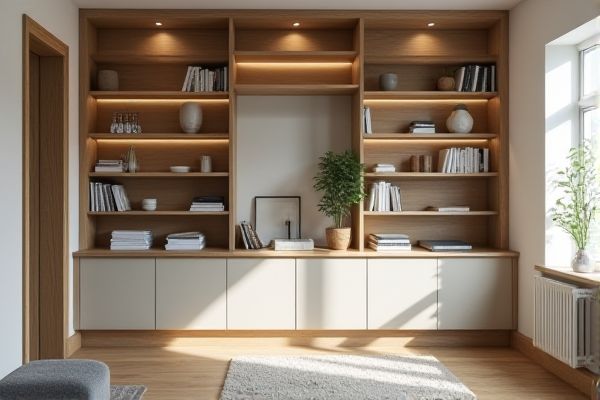
Open cubbies offer easy access and visibility, ideal for frequently used items, while closed cubbies provide a cleaner, more organized appearance by concealing clutter and protecting contents from dust. Explore the rest of the article to determine which cubby style best suits Your storage needs and aesthetic preferences.
Table of Comparison
| Feature | Open Cubby | Closed Cubby |
|---|---|---|
| Accessibility | Easy and quick access | Restricted access via door or panel |
| Visibility | Items are fully visible | Items hidden from view |
| Security | Minimal security | Enhanced security and privacy |
| Dust Protection | Low protection | High protection against dust |
| Aesthetic | Casual, open look | Neat, organized appearance |
| Use Cases | Display items, easy retrieval | Secure storage, privacy needs |
Introduction to Open and Closed Cubbies
Open cubbies offer easy access and visibility, making organization simple in spaces like classrooms or entryways. Closed cubbies provide privacy and protect items from dust or damage, ideal for storing personal belongings securely. Choosing between open and closed cubbies depends on your need for accessibility versus protection in storage solutions.
Key Differences Between Open and Closed Cubbies
Open cubbies provide easy access and visibility, ideal for frequently used items and quick organization. Closed cubbies offer privacy and protection from dust, making them suitable for storing valuables or less attractive items. The choice depends on balancing accessibility with security and aesthetics in storage solutions.
Pros of Open Cubbies
Open cubbies provide easy access and visibility, making organization and retrieval of items faster and more convenient. They promote airflow, reducing the risk of mold or odors, especially in storage for shoes or toys. Their design can create a more open and inviting space compared to closed cubbies, enhancing room aesthetics.
Cons of Open Cubbies
Open cubbies often accumulate dust and clutter more quickly, making organization and cleanliness a challenge for your space. Lack of privacy can expose personal or valuable items, increasing the risk of damage or theft in busy environments. Limited visual appeal might detract from a polished look, especially in professional or formal settings where closed cubbies provide a neater, more streamlined appearance.
Pros of Closed Cubbies
Closed cubbies offer enhanced security and privacy by protecting items from dust, dirt, and unauthorized access. These storage solutions help maintain a clean, organized appearance in your space and reduce visual clutter. You benefit from added protection for valuable or sensitive items, making closed cubbies ideal for both home and office environments.
Cons of Closed Cubbies
Closed cubbies often limit visibility, making it difficult to quickly identify stored items compared to open cubbies. They can also create a sense of confinement or clutter if not properly organized, as items hidden behind doors may accumulate unnoticed. Additionally, closed cubbies may require more maintenance and care to keep doors functioning smoothly and surfaces clean.
Ideal Settings for Open Cubbies
Open cubbies are ideal for environments that require easy access and frequent use, such as classrooms, gyms, or collaborative workspaces. They promote visibility and organization by allowing users to quickly identify and retrieve items without opening doors or drawers. Ideal settings also include homes or offices where open display of personal items or frequently used materials enhances accessibility and aesthetic appeal.
Ideal Settings for Closed Cubbies
Closed cubbies are ideally suited for environments requiring enhanced organization and security, such as schools, offices, and gyms where personal belongings need to be protected from dust and unauthorized access. These storage units offer privacy and reduce visual clutter, making them perfect for sensitive or valuable items. Enclosed spaces in closed cubbies improve cleanliness control and help maintain an orderly appearance in professional and educational settings.
Factors to Consider When Choosing Between Open and Closed Cubbies
Choosing between open and closed cubbies depends on factors like accessibility, visibility, and security needs. Open cubbies offer easy access and quick identification of stored items but lack privacy and protection from dust. Closed cubbies provide concealed storage, enhanced security, and a cleaner appearance, ideal for organizing sensitive or less frequently used belongings.
Conclusion: Which Cubby Style Is Right for You?
Open cubbies offer easy access and visibility, making them ideal for frequently used items and creating an airy, organized look. Closed cubbies provide a cleaner appearance by concealing clutter, enhancing privacy and protection from dust. Choosing between open and closed cubbies depends on your storage needs, aesthetic preferences, and the level of accessibility or concealment you desire in your space.
 homyna.com
homyna.com